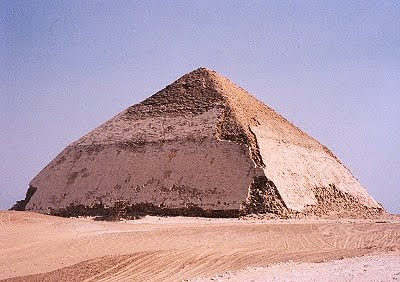Philosophy
 Bent Pyramid at Dahshur Egypt
Bent Pyramid at Dahshur Egypt
The lower part of the pyramid has an angle of 54° and the upper part is at 43°. Why is it bent?
1.) Time and/or money. Basically this idea says that they either didn’t have the time or money to finish the pyramid at the initial slope. To cut costs [or time] they changed the angle.
2.) Material failure. Building the pyramid at the original slope caused structural instabilities. Either the foundation couldn’t take the weight or the building material itself started to crack.
3.) Alien sense of humor.
Bent Pyramid [Wikipedia]
THE GEOMETRY OF THE BENT PYRAMID
- Don't Anger The Mayan Gods
"Idiot Construction Crew Demolishes 2,300-year-old Maya Pyramid" by George Dvorsky May 15th, 2013 io9 An investigation is now underway after one of the largest Maya pyramids in Belize was bulldozed to extract materials for a road project. Stuff like...
- Pyramidal Mars Rock And Curiosity Get Together
In a series of new raw images taken by Mars rover Curiosity's Navcams, it appears that mission managers have given the command for the rover's robotic arm to reach out to its first contact science target, a pyramid-shaped rock named "Jake...
- New Egyptian Pyramids Found By Using Nasa Technology
"Lost Egyptian Pyramids Found?" by Rossella Lorenzi August 10th, 2012 DiscoveryNewsTwo possible pyramid complexes might have been found in Egypt, according to a Google Earth satellite imagery survey.Located about 90 miles apart, the sites contain unusual...
- Curious Piece From A Royal Tomb In Guatemala
No people, it isn't an alien in a flying saucer. Archaeology magazine has listed it as one of ten best discoveries of 2010. "Royal Tomb - El Zotz, Guatemala" by Samir S. Pate January/February 2011 Archaeology A deep looters' trench led archaeologists...
- Ancient Egyptian Concepts Of Evil--new Book
The Question of Evil in Ancient Egypt by S. J. Mpay Kemboly ISBN 978-1906137151 The book examines relevant sources from the Old Kingdom Pyramid Texts (c. 24th century B.C.E.) to the Graeco-Roman Period inscriptions (2nd century C.E.) in order to understand...
Philosophy
Curious pyramid...the "Bent Pyramid"
 Bent Pyramid at Dahshur Egypt
Bent Pyramid at Dahshur EgyptThe lower part of the pyramid has an angle of 54° and the upper part is at 43°. Why is it bent?
1.) Time and/or money. Basically this idea says that they either didn’t have the time or money to finish the pyramid at the initial slope. To cut costs [or time] they changed the angle.
2.) Material failure. Building the pyramid at the original slope caused structural instabilities. Either the foundation couldn’t take the weight or the building material itself started to crack.
3.) Alien sense of humor.
Bent Pyramid [Wikipedia]
THE GEOMETRY OF THE BENT PYRAMID
- Don't Anger The Mayan Gods
"Idiot Construction Crew Demolishes 2,300-year-old Maya Pyramid" by George Dvorsky May 15th, 2013 io9 An investigation is now underway after one of the largest Maya pyramids in Belize was bulldozed to extract materials for a road project. Stuff like...
- Pyramidal Mars Rock And Curiosity Get Together
In a series of new raw images taken by Mars rover Curiosity's Navcams, it appears that mission managers have given the command for the rover's robotic arm to reach out to its first contact science target, a pyramid-shaped rock named "Jake...
- New Egyptian Pyramids Found By Using Nasa Technology
"Lost Egyptian Pyramids Found?" by Rossella Lorenzi August 10th, 2012 DiscoveryNewsTwo possible pyramid complexes might have been found in Egypt, according to a Google Earth satellite imagery survey.Located about 90 miles apart, the sites contain unusual...
- Curious Piece From A Royal Tomb In Guatemala
No people, it isn't an alien in a flying saucer. Archaeology magazine has listed it as one of ten best discoveries of 2010. "Royal Tomb - El Zotz, Guatemala" by Samir S. Pate January/February 2011 Archaeology A deep looters' trench led archaeologists...
- Ancient Egyptian Concepts Of Evil--new Book
The Question of Evil in Ancient Egypt by S. J. Mpay Kemboly ISBN 978-1906137151 The book examines relevant sources from the Old Kingdom Pyramid Texts (c. 24th century B.C.E.) to the Graeco-Roman Period inscriptions (2nd century C.E.) in order to understand...
